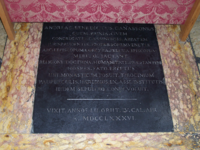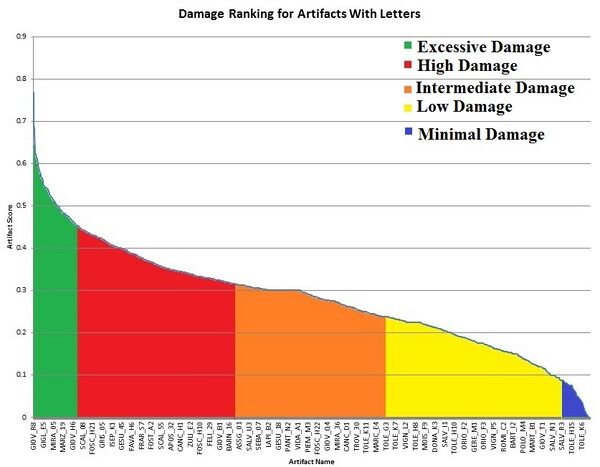Church Floor Artifact: Difference between revisions
ChurchesB12 (talk | contribs) |
ChurchesB12 (talk | contribs) No edit summary |
||
| Line 26: | Line 26: | ||
==Classification== | ==Classification== | ||
There are two types of artifacts found in the [[Churches]] of Venice: tombs, the more common artifact, and plaques, which only have incription and do not mark a body's resting place. | |||
===Tombs=== | ===Tombs=== | ||
A tomb, or ''tomba'', is the most common form of floor artifact and mark the location of a burial. Due to health concerns of and flooding, the body may have been moved and may no longer be in the Church. A tomb marker is either a large rectangle or small square, depending on the type of burial and the wealth of the family. All tombs contain some amount of inscription, but the amount of information included ranges from a full obituary to simply DOM. Both types of tombs are shown below. | A tomb, or ''tomba'', is the most common form of floor artifact and mark the location of a burial. Due to health concerns of and flooding, the body may have been moved and may no longer be in the Church. A tomb marker is either a large rectangle or small square, depending on the type of burial and the wealth of the family. All tombs contain some amount of inscription, but the amount of information included ranges from a full obituary to simply DOM, which stands for, "Deo, Optimo, Maximo (to God, the Best, the Greatest)" or "Domino, Optimo, Maximo (the Lord, the Best, the Greatest)." These are the mottos of the Bendictine order. <ref>http://www.alsirat.com/symbols/latin.htmlhttp://www.alsirat.com/symbols/latin.html</ref> Both types of tombs are shown below. | ||
<gallery> | <gallery> | ||
| Line 45: | Line 47: | ||
==Condition Evaluation== | ==Condition Evaluation== | ||
There are 5 types of damage that were evaluated by teams from Worcester Polytechnic Institute (WPI). These types are damage are: | |||
*Fading and Wear: | |||
*Text readability: The readibility of the text on an artifact was based upon the condition of each letter. Letter were judged to be in perfect condition, damaged but readiable or completely unreadable. | |||
*Cracks: A value of 0 to 4 was used to rate how cracked an artifact was. | |||
{| class="wikitable" | |||
|- | |||
! Scale !! Description | |||
|- | |||
| 0 || Minimal or no cracks | |||
|- | |||
| 1 || Low level of cracks, none considered problematic | |||
|- | |||
| 2 || Some problem cracks or many small cracks | |||
|- | |||
| 3 || Siginificant amout of problem cracks or many small cracks | |||
|- | |||
| 4 || Many problmem cracks and small cracks | |||
|}<ref>Gagnon, David Thompson, Kelly, Ruscitti, Eric. ''Embedded Heritage: A Study of Venetian Church Floors.'' An Interactive Qualifying Project for Worcester Polytechnic Institute. 2005. </ref> | |||
*Holes: | |||
*Joint gaps: <ref>Gagnon, David Thompson, Kelly, Ruscitti, Eric. ''Embedded Heritage: A Study of Venetian Church Floors.'' An Interactive Qualifying Project for Worcester Polytechnic Institute. 2005. </ref> | |||
<gallery> | |||
File: | |||
</gallery> | |||
==Condition Ranking== | |||
In order to create a ranked list of artifact damage, an equation that takes into account the five different types of damage assessed was developed by a team or researches from WPI. The equation was developed through experimentation with different weights in the equation so that could be seen visually (such as surface damage and text wear) could be expressed numerically. This equation and condition evaluation was developed for this website and is not recognized by other outside organizations. After using the following equation to standardize the rankings assigned to each artifact, the conditions were divided into five categories of damage. | |||
[[File:Color Coded Graph (2).jpg|600px|center|distribution of damage]] | [[File:Color Coded Graph (2).jpg|600px|center|distribution of damage]] | ||
| Line 51: | Line 80: | ||
(.25)(Fading and Wear) + (.25)(Readability) + (.20)(Cracks) + (.05)(Holes) + (.20)(Joint Gaps) | (.25)(Fading and Wear) + (.25)(Readability) + (.20)(Cracks) + (.05)(Holes) + (.20)(Joint Gaps) | ||
The five categories of damage are as follows. Image from each damage type can be seen below: | |||
The five categories of damage are as follows: | |||
* | *'''Excessive Damage''': The artifact is too far degraded that no more information would be saved if the artifact were to undergo restoration. | ||
''' | *'''High Damage''': The artifact is in need of preservation in order to maintain the image or text visible on the artifact. The text is still readable, but is in danger of being worn away to an extent that would lose all information on it. | ||
''' | *'''Intermediate Damage''': The artifact has sustained some damage in any of the mentioned types of damage, but is still mostly readable. Preservation could occur, but the artifact is not yet in critical condition. | ||
''' | *'''Low Damage''': The artifact has very little damage on its surface. The text is nearly flawless and only minimal efforts would need to be made in order to maintain the artifact. | ||
*'''Minimal Damage''': The artifact has hardly any damage, all the text and artwork is readable. At this time, there is no need for preservation.<ref>Dechaine, Danielle, Hennessey, Meghan, Orszulak, Jeffrey, Rullmann, Kevin. ''Treasures Underfoot: Preserving Venice's Church Floor Artifacts.'' An Interactive Qualifying Project for Worcester Polytechnic Institute. 2012.</ref> | |||
<gallery> | |||
'''Minimal Damage''': The artifact has hardly any damage, all the text and artwork is readable. At this time, there is no need for preservation.<ref>Dechaine, Danielle, Hennessey, Meghan, Orszulak, Jeffrey, Rullmann, Kevin. ''Treasures Underfoot: Preserving Venice's Church Floor Artifacts.'' An Interactive Qualifying Project for Worcester Polytechnic Institute. 2012.</ref> | File:Excessive_Damage_1.png|An artifact in the excessive damage catagory | ||
File:High_Damage_1.png|An artifact in the high damage catagory | |||
File:Intermediate_Damage_1.png|An artifact in the intermediate damage catagory | |||
File:Low_Damage_1.png|An artifact in the low damage catagory | |||
File:Minimal_Damage_1.png|An artifact in the minimal damage catagory | |||
</gallery> | |||
==See Also== | ==See Also== | ||
Revision as of 15:24, 22 December 2012
This article contains information on a typical Church Floor Artifact.
For a list of Churches, see Churches. For a more information on the artifacts, see Church Floor Artifacts.
 | |
| Total Number of Artifacts | 2221 |
|---|---|
Classification
There are two types of artifacts found in the Churches of Venice: tombs, the more common artifact, and plaques, which only have incription and do not mark a body's resting place.
Tombs
A tomb, or tomba, is the most common form of floor artifact and mark the location of a burial. Due to health concerns of and flooding, the body may have been moved and may no longer be in the Church. A tomb marker is either a large rectangle or small square, depending on the type of burial and the wealth of the family. All tombs contain some amount of inscription, but the amount of information included ranges from a full obituary to simply DOM, which stands for, "Deo, Optimo, Maximo (to God, the Best, the Greatest)" or "Domino, Optimo, Maximo (the Lord, the Best, the Greatest)." These are the mottos of the Bendictine order. [1] Both types of tombs are shown below.
-
Example of a rectangular tomb
-
Example of a small tomb
Plaques
A plaque, or placca, is the second type of artifact. A plaque has an inscription, but is not a tomb. They often represent years of construction/restoration or prominent contributors. More importantly, they do not mark the final resting place of someone. Plaques are less common than tombs and are often smaller. An example can be seen below.
-
Example of a plaque
Condition Evaluation
There are 5 types of damage that were evaluated by teams from Worcester Polytechnic Institute (WPI). These types are damage are:
- Fading and Wear:
- Text readability: The readibility of the text on an artifact was based upon the condition of each letter. Letter were judged to be in perfect condition, damaged but readiable or completely unreadable.
- Cracks: A value of 0 to 4 was used to rate how cracked an artifact was.
| Scale | Description |
|---|---|
| 0 | Minimal or no cracks |
| 1 | Low level of cracks, none considered problematic |
| 2 | Some problem cracks or many small cracks |
| 3 | Siginificant amout of problem cracks or many small cracks |
| 4 | Many problmem cracks and small cracks |
- Holes:
- Joint gaps: [3]
Condition Ranking
In order to create a ranked list of artifact damage, an equation that takes into account the five different types of damage assessed was developed by a team or researches from WPI. The equation was developed through experimentation with different weights in the equation so that could be seen visually (such as surface damage and text wear) could be expressed numerically. This equation and condition evaluation was developed for this website and is not recognized by other outside organizations. After using the following equation to standardize the rankings assigned to each artifact, the conditions were divided into five categories of damage.

(.25)(Fading and Wear) + (.25)(Readability) + (.20)(Cracks) + (.05)(Holes) + (.20)(Joint Gaps)
The five categories of damage are as follows. Image from each damage type can be seen below:
- Excessive Damage: The artifact is too far degraded that no more information would be saved if the artifact were to undergo restoration.
- High Damage: The artifact is in need of preservation in order to maintain the image or text visible on the artifact. The text is still readable, but is in danger of being worn away to an extent that would lose all information on it.
- Intermediate Damage: The artifact has sustained some damage in any of the mentioned types of damage, but is still mostly readable. Preservation could occur, but the artifact is not yet in critical condition.
- Low Damage: The artifact has very little damage on its surface. The text is nearly flawless and only minimal efforts would need to be made in order to maintain the artifact.
- Minimal Damage: The artifact has hardly any damage, all the text and artwork is readable. At this time, there is no need for preservation.[4]
-
An artifact in the excessive damage catagory
-
An artifact in the high damage catagory
-
An artifact in the intermediate damage catagory
-
An artifact in the low damage catagory
-
An artifact in the minimal damage catagory
See Also
References
- ↑ http://www.alsirat.com/symbols/latin.htmlhttp://www.alsirat.com/symbols/latin.html
- ↑ Gagnon, David Thompson, Kelly, Ruscitti, Eric. Embedded Heritage: A Study of Venetian Church Floors. An Interactive Qualifying Project for Worcester Polytechnic Institute. 2005.
- ↑ Gagnon, David Thompson, Kelly, Ruscitti, Eric. Embedded Heritage: A Study of Venetian Church Floors. An Interactive Qualifying Project for Worcester Polytechnic Institute. 2005.
- ↑ Dechaine, Danielle, Hennessey, Meghan, Orszulak, Jeffrey, Rullmann, Kevin. Treasures Underfoot: Preserving Venice's Church Floor Artifacts. An Interactive Qualifying Project for Worcester Polytechnic Institute. 2012.
Bibliography
S. Hoey, M. Kahan, P Marchetti, K Mazza. Convents, Palaces and Churches: Transformation of Historic Buildings and the Impact on Venice’s Neighborhoods. An Interactive Qualifying Project for Worcester Polytechnic Institute. 2003.
Santos,Luiz G., Petrowski,Craig Peter, Kristant,Elaine Hazel, Delaive,Amanda Leigh. The Church Floors in Venice, Italy -- an Archeological Study and Analysis. An Interactive Qualifying Project for Worcester Polytechnic Institute. 2002.
External Links
None







